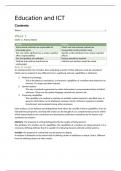Education and ICT
Contents
Week 1...................................................................................................................................................1
Week 1
Clarke v.s. Kozma debate
Clarke Kozma
Instructional methods are responsible for Media and instructional method are
knowledge gains inseparable (constructivistic view)
Not one media attribute has a unique cognitive Specific media attributes have unique cognitive
effect (replaceability) effects
Pre- and posttest are sufficient Process should be involved
Method and medium should not be Method and medium should be mixed
confounded
Role of media
To understand the role of media, their underlying currents of their influence must be considered.
Media can be analysed in two different terms: cognitively relevant capabilities or attributes.
1. Medium’s technology
This is the physical, mechanical, or electronic capabilities of a medium that determine its
function, it’s shape and other features.
2. Symbol systems
The sets of symbolic expressions by which information is communicated about a field of
reference. These are the spoken language, printed text, pictures etc.
3. Processing capabilities
The capability of a medium to operate on available symbol systems in specified ways. In
general, information can be displayed, received, stored, retrieved, organized, translate,
transformed, and evaluated among other processes.
Each medium can be defined and distinguished from others by a profile of these capabilities. Form an
interactionist perspective, learning with media can be thought of as a complementary process within
which representations are constructed and procedures performed, sometimes by the learner and
sometimes by medium.
Attribute: The property of a thing distinguished by the quality of being present
The attributes of a medium are its capabilities: the capabilities of a medium are always present. It is a
necessary, defining attribute that it is capable of employing dynamic pictorial symbol systems.
Variable: the property of a thing that may be present in degree.
A medium is distinctive to the extent that its defining cluster of attributes is unique, that is, different
from the defining clusters of other media.
,Week 2
Learning theories
Learning theories is a very broad term with many perspectives.
Learning theories
Behaviourism Cognitivism Constructivism Connectivism
What is Conditioning, Processing Constructing and Distributed
learning? reacting information, active creating knowledge knowledge,
(re)construction by themselves, network, self-
interaction organising
Role of student Passive Active Active Active
Role of teacher Input / stimuli Support and To guide, ?
Repeating, structure learning scaffolding, adapts
appropriate process to lever of learner,
output response fades away their
help
Educational technology holds a double meaning:
a) Application of scientific know-how
b) Tools or equipment
Educational technology must be embedded in (learning) theories so that learning insights can be
converted into clear applicable guidelines for ICT tools. This prevents the effectiveness of those tools
from becoming dependent on the expertise of the users. Educational technology is developing and
learning is becoming increasingly complex, which means that (learning) theories must also develop
further.
There are five observations made:
1. Evolutions in Society and Education Have Influenced the Selection and Use of Learning
Theories and Technologies
2. Learning theories and technologies are situated in a somewhat vague conceptual field.
3. Learning theories and technologies are connected and intertwined by information processing
and knowledge acquisition.
4. Educational technologies have shifted learner support from program or instructor control
toward more shared and learner control.
5. Learning theories and findings represent a fuzzy mixture of principles and applications.
Dimensions of E-learning
Dimensie Attributen Betekenis Voorbeeld
Synchronous Asynchroon Instruction occurs at a different time Kennisclips
from when the learner receives it
Synchronous Instruction occurs at the same time Teams meeting
when the learner receives it
Location Same location Learners use an application at the Using GSS to solve a
same time in the same location as problem in the
the other students and teacher classroom
Dispersed Learners use an application in Using GSS in
different places from other learners dispersed locations
, and teachers
Independence Individually Learners work independently to e-learnings made
complete learning tasks individually
Collaborative Learners work together to complete Learners collaborate
learning tasks in discussion forums
Mode Electronical All content is delivered online,
nothing is face-to-face
Blended E-learning is used to complement
normal classroom formats
Stakeholders
Short list of stakeholders (not everything)
Motivations Concerns
Students Access higher education A different skill set is needed.
Instructors Pressure from higher-up, Need to have the knowledge
wishing to reach a wider on how to integrate ICT into
audience. the lessons. (TPACK)
School management / Provide vision and plan, Budget, resistance from
educational institutes administrative and faculties.
infrastructure support, system
reliability and security and
lastly, opportunities to
experiment
Content providers To provide content modules Copy rights
that will result in effective
learning.
Commercial content providers
are motivated by profit
Technology providers Provide learning environments Technology standards.
Constant evolution.
Accreditation Bodies They need to encompass e- High volume of work
learning into their standards
Employers They need to consider e- Decreased interpersonal
learning as a higher education interaction inherent in many of
alternative. these courses. They think
interpersonal skills to be very
important




